Shopify vs eBay: What is the Best Platform For Scaling Ecommerce Brands?
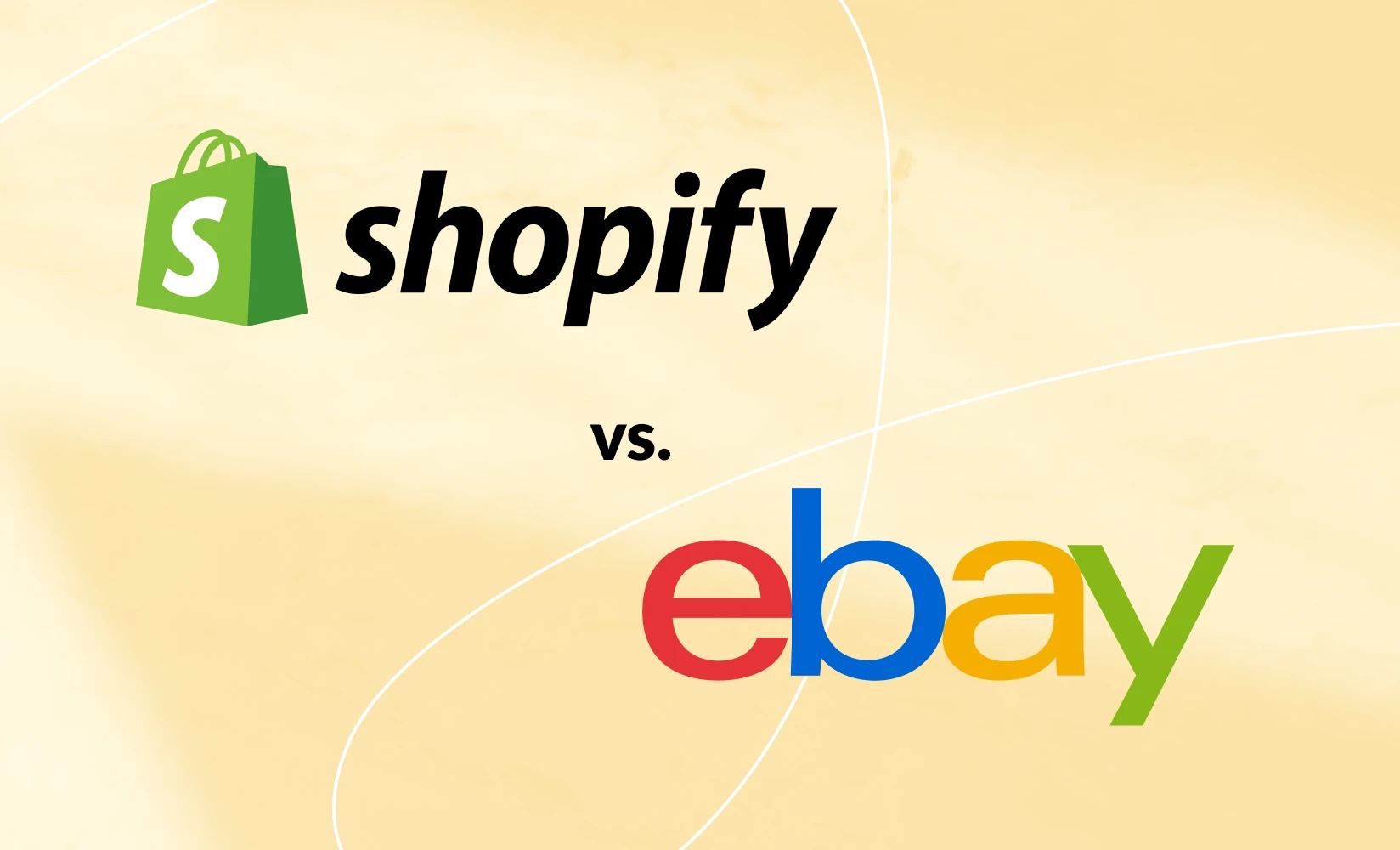
Your sales channel will guide how you sell online—whether you need to focus more on branding for a DTC store, or listing optimization for a marketplace.
For example, choosing between Shopify vs eBay has ramifications on your sales strategy thanks to their unique use cases, sales styles, and audiences.
Since one is an ecommerce platform and the other a marketplace, you should analyze your business setup and needs to determine which is best for your brand.
So, whether you’re in the early stages of building a brand, or are seasoned enough to seek expansion, it’s vital to understand both Shopify and eBay’s nuances to make the right selection.
In this article, we’ll delve into both platforms, dissecting their advantages and drawbacks, features, and best-fitting circumstances.
Read on to learn:
By the end, this deep dive will have you facing the right direction—towards the platform that’ll drive your ecommerce aspirations.
#cta-visual-pb#<cta-title>Grow your business with strategic landing pages<cta-title>Craft the ideal experience for your visitors and optimize your landing pages for maximum conversions.Start designing for free
Shopify: An ecommerce powerhouse

Shopify is a comprehensive solution, providing millions of merchants in over 170 countries a canvas for creating and managing their branded online stores.
It comes with an assortment of functionalities, covering:
- Website customization
- Product and inventory management
- Secure payment processing
- Marketing and SEO
- Fulfillment
Combined, those features enable you to produce an exceptional shopping experience.
Whether you’re an individual selling handmade crafts or an enterprise advertising sophisticated goods, Shopify offers a complete package that meets all your needs.
eBay: A marketplace giant
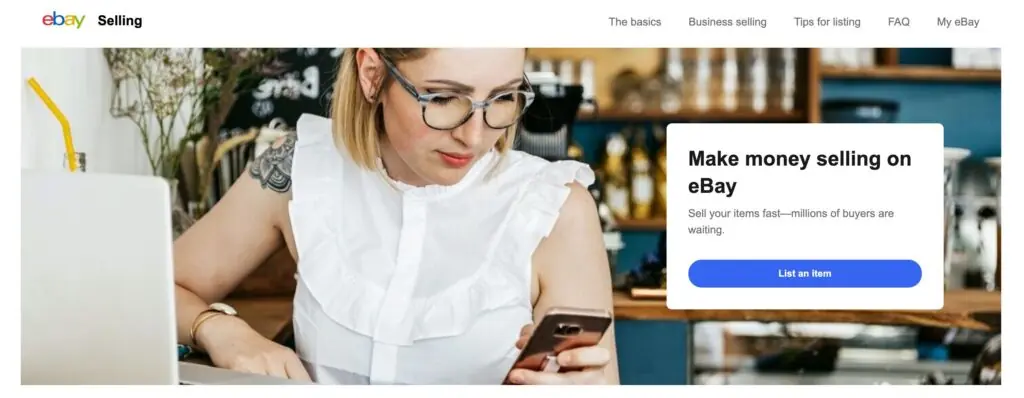
eBay, meanwhile, is a well-established online marketplace where millions of sellers across 190 markets enjoy access to a vast, diverse audience.
Rather than building a standalone store on the platform, businesses leverage its reputation and user base.
eBay provides a unique selling environment thanks to unique characteristics like:
- Auction-style and fixed-price listings
- Built-in trust and reputation systems
- Global shipping options
- Advertising tools
This platform is an enticing choice in particular for businesses looking to maximize a deep, pre-existing pool of buyers.
Shopify vs eBay: Pros and cons
Before we go into a head-to-head of these two platforms, let’s first talk about the general pros and cons of each to get a bird’s eye view of the differences right away.
Pros and cons of Shopify
| Pros | Cons |
|---|---|
| Deep customization and branding | Transaction fees |
| Supports various products and services | Complex store design needs coding or apps |
| Empowers brands both large and small | Learning curve for beginners |
| Built-in marketing and search engine optimization (SEO) | Requires maintenance |
| Secure payments | Premium themes and apps cost extra |
| 24/7 customer support | |
| Extensive app ecosystem |
Pro: Deep customization and branding
Shopify lets you dictate your website’s look and feel and align every element with your branding. Merchants get full control to build a unique and memorable shopping experience.
Its themes, editor, and store code customization enable intricate designs for your store’s aesthetic all the way to the checkout process.
#cta-visual-pb#<cta-title>Bring your designs to life<cta-title>Use Shogun Page Builder for a seamless drag-and-drop design experience that anyone can master.Start designing for free
Pro: Support for various products and services
Shopify is known more for enabling the online selling of physical goods, but its flexibility also lets you offer services and digital goods, opening the door to various types of business ventures.
Pro: Empowers small to massive brands
Every Shopify plan provides unlimited products and bandwidth, meaning you can sell an infinite number of items and accommodate endless amounts of website visitors to build a thriving ecommerce business.
You can easily upgrade your subscription for more powerful functionalities as well, making the platform a highly scalable option.
Pro: Built-in marketing and SEO
Shopify comes with marketing tools for various channels, including:
- Content marketing
- SEO
- Social media
- Chat
Reporting and analytics capabilities are also built-in, which you can use to measure results and optimize your strategies for driving traffic.
Pro: Secure payments
Shopify adheres to Payment Card Industry Data Security Standards (PCI DSS) and General Data Protection Regulations (GDPR), so sellers and buyers alike can feel confident doing business on the platform.
It also offers multiple payment options, ranging from Shopify Payments (the platform’s own gateway) to third-party options.
Pro: 24/7 customer support
You gain access to round-the-clock support as a Shopify merchant and through multiple channels too.
With the platform’s team constantly available, any possible issues you encounter will take less time to resolve.
Pro: Extensive app ecosystem
To make up for any functionalities it lacks, Shopify maintains a vast library of integrations for:
- Finding and selling products
- Streamlining orders and shipping
- Store customization
- Marketing
- Overall website management
Con: Transaction fees
If you go through a third-party payment processor instead of Shopify Payments, you incur the platform’s transaction fees.
Shopify also charges a small amount to accept major credit cards like Mastercard and Visa as payment in your store.
Fees vary according to your plan, but they can easily eat into your profit margins as they pile up.
Con: Learning curve for beginners
Shopify is user-friendly, but complete website setup and customization will take time to learn, especially for ecommerce newbies or those who lack technical know-how.
For instance, intricate website designs can require coding, and each Shopify app has its own configurations.
Con: Requires maintenance
As a business owner, keeping your Shopify website healthy is your duty. Whereas eBay has their own team to handle security, website updates, performance optimization, and the like, Shopify store owners are responsible for maintaining their website functionality and security.
Con: Premium themes and apps add to your expenses
Shopify themes and apps add to your store’s design and functionality, but more advanced ones come at a price, whether it be through a subscription or usage-based charges.
Free themes are available, but their features are limited.
Pros and cons of eBay
| Pros | Cons |
|---|---|
| Global audience | Listing fees and final value fees |
| Easy setup | Limited customization |
| Advertising and promotional tools | Stiff competition |
| Sellers are protected | Stringent policies |
| Rich in shipping options | |
| No subscription required |
Pro: Global audience
“eBay is an established marketplace with a huge brand presence and a steady stream of traffic, landing daily with intentions to purchase. For this reason, it can save a lot of time and effort in setting up a website and building demand.”
— Sam McEwin, BizWisdom founder and director
eBay boasts 132 million active buyers globally. Setting up shop on the platform thus offers your brand the opportunity to tap into this massive and diverse user base.
Pro: Easy setup
Launching an eBay store is simple and only involves:
- Creating a business account on the platform
- Providing eBay with the necessary information throughout the process
- Connecting a payment service provider
Once done, you can start listing products for sale. If you want a customizable storefront, however, you must choose eBay’s second-lowest plan or higher.
Pro: Advertising and promotional tools
eBay’s tools enable you to offer discounts and coupons, as well as advertise your listings across the platform and its partner sites (which include affiliates and their audiences).
You can connect your store to social media platforms as well.
Pro: Sellers are protected
The platform implements various seller protections against abusive buying activities to reduce your security risk. For instance:
- False claims from customers entitle you to return shipping label subsidies, while eBay removes their negative feedback.
- If an item is returned after the buyer damaged it, you can recover some of its value by deducting up to half of the refund.
Pro: Rich in shipping options
eBay provides an abundant selection of domestic and international shipping options for products of all sizes.
You can sell anything, from trinkets to large appliances, to anyone, anywhere.
Pro: No subscription required
You don’t need a subscription to sell on eBay, and fees are only charged for products you’ve successfully listed and sold.
Opting out of eBay’s plans, however, means you miss out on a customizable storefront.
Con: Multiple fees
Fees are only incurred for sold items, but eBay charges more on top of them: You typically pay listing and final value fees, but they also charge for subscriptions, international sales, and more.
These can quickly add up, meaning lower profitability on eBay.
Con: Limited customization
eBay’s design and branding options are extremely limited, and store layouts, as well as checkout processes, are uniform for sellers across the platform.
Con: Stiff competition
As previously mentioned, eBay hosts millions of sellers across 190 markets, meaning you’ll have a huge number of people to compete with.
“Since it’s a pure marketplace, if someone has the same product at a cheaper price, why would anyone purchase from you?” reasons Sam McEwin, founder and director of BizWisdom.
“For that reason, eBay can tend to be a quick race to the bottom.”
Con: Stringent policies
eBay implements a multitude of policies that dictate how you do business and interact with customers.
As a result, you lack the freedom to provide an on-brand shopping experience, which Sam reiterates:
“Building a business on the shifting sands of someone else’s platform is a risky affair. For one, you’re at the complete mercy of eBay’s policies, and they can change to your detriment without notice! In the blink of an eye, your successful shop could be dead and gone.”
Shopify vs eBay: Feature breakdown
Now that you have an idea of each platform’s benefits and drawbacks, we’ll break down their features for a deeper comparison.
| Feature | Details | Winner | Reason |
|---|---|---|---|
| Pricing and fees | Shopify ranges from $5 to $2,000 per month. eBay ranges from $4.95 to $2,999.95 per month. | Shopify | Shopify doesn’t charge listing fees, meaning costs don’t scale with growth in the same way as on eBay. |
| Ease of use | Shopify has plenty of different options that add complexity to setup, but makes it easy to get started and add integrations. eBay has a simpler set up, but the user interface is more dated and difficult to use. | Shopify | Shopify offers a more intuitive and modern UX. |
| Payment options | Both platforms support credit cards, debit cards, digital wallets such as Apple Pay, and PayPal. Depending on the country, eBay offers checks, money orders, and cash upon pick-up or delivery. Shopify also provides Shopify Payments and Shop Pay. | Tie | Although eBay has certain payment methods Shopify doesn’t, Shopify competes with Shopify Payments, helping merchants save in selling fees. |
| Customization and branding | Shopify provides control over the entire website where your shoppers visit. eBay has set templates and a menu and homepage that you cannot control. You also cannot adjust which competitor listings are shown alongside yours. | Shopify | Shopify allows you to customize your entire shopper experience, whereas eBay only allows customization within your listing and shop. |
| Marketing and SEO | Shopify comes with many beneficial SEO tools and marketing integrations that you can add with the click of a button. eBay comes with a pre-built audience of shoppers that go to eBay purposefully to shop, helping with buyer acquisition. | Tie | Shopify provides better marketing tools whereas eBay brings a ready-made audience of shoppers. |
| Ecommerce tools and apps | eBay has a handful of useful tools to help you sell, including a research tool, listing tool, inventory syncing, and more. Shopify comes with a robust app ecosystem that has tools for whatever functionality a merchant may need. | Shopify | Shopify’s famous app ecosystem has more tools and apps. |
| Omnichannel selling | eBay allows you to integrate with social profiles to post and share your listings. Shopify integrates with social, messenger apps, and other sales channels to sync data and sell more efficiently. Shopify also has a POS for physical retail stores. | Shopify | Shopify comes with more features and tools to enable multi-channel selling. |
| Fulfillment and shipping | Both Shopify and eBay have tried to make it easy to ship items and track deliveries from their platforms. | It depends | Shopify has a managed logistics service, and eBay has a global shipping program. |
| Customer support | Shopify provides support pages, messaging, and chat. Depending on your plan, eBay provides a help center, an automated assistant, and a help agent. Both have active and helpful user communities. | Shopify | Shopify guarantees support across all of their plans, making them the fairer choice when it comes to merchant support provided. |
Pricing and fees
Both Shopify and eBay provide tiered pricing for their subscription plans, with distinct offers (as they follow different sales models) and various additional fees.
Shopify
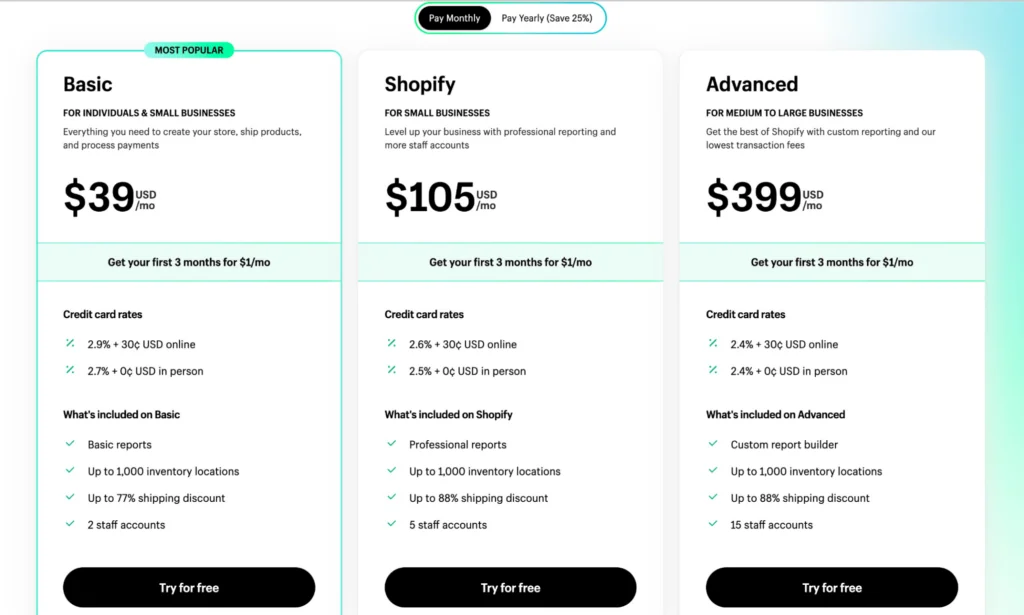

Shopify plans, for instance, range from:
- Starter: $5/month
- Basic: $39/month
- Retail: $89/month
- Shopify: $105/month
- Advanced: $399/month
- Shopify Plus: Starts at $2K/month
Shopify’s plans range from their entry-level starter pack that allows selling through social and messaging (although no website) to Shopify Plus, which is designed for enterprise merchants with additional functionality.
Merchants who are just starting out and don’t have the time or resources to build their own store may want to stick to selling on social with the Starter plan.
Those wanting to sell in brick-and-mortar stores might opt for the Retail plan (an additional subscription for the POS system), and merchants who want to start growing their business might go for the Shopify plan to access multiple staff accounts.
Additionally, if you employ third-party payment processors, you’ll incur transaction fees of 2%, 1%, or 0.5% for Shopify’s Basic, Shopify, and Advanced plans, respectively.
Shopify’s wide range of plans shows they’ve considered multiple different merchant scenarios and how they can best help.
To better understand the available choices, read our posts showing how to choose the right Shopify plan, as well as how they compare to Shopify Plus.
eBay
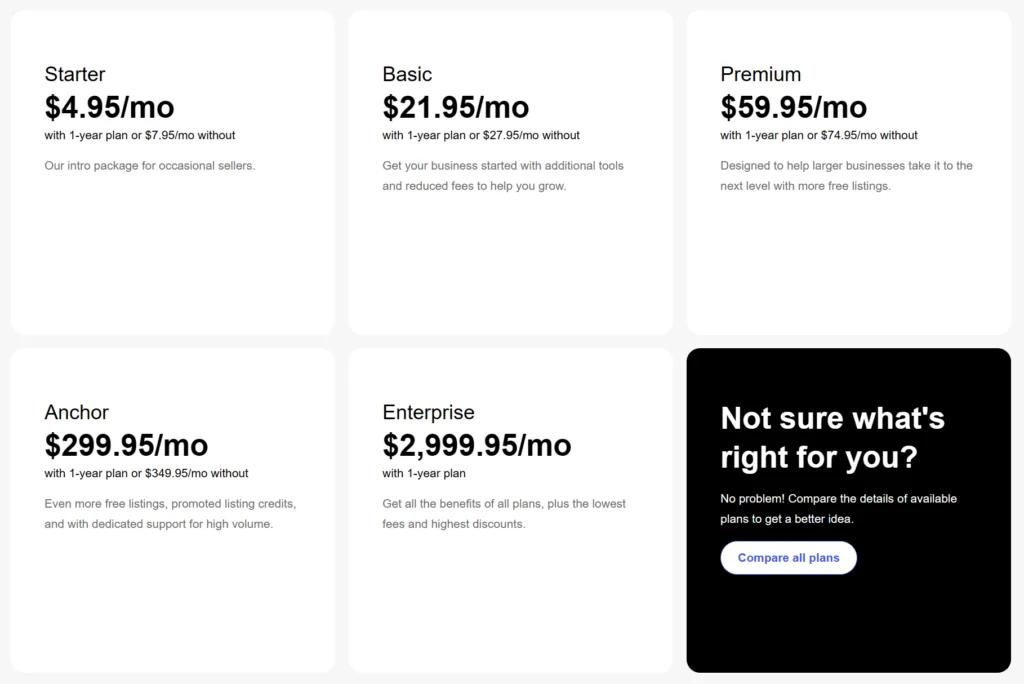
You don’t need a subscription to sell on eBay, but having one lets you enjoy free listings, discounts, and lower fees.
Monthly plans, meanwhile, will net you the following costs:
- Starter: $7.95/month
- Basic: $27.95/month
- Premium: $74.95/month
- Anchor: $349.95/month
- Enterprise: Only available through a yearly subscription at $2,999.95/month
eBay also charges product category-based fees on top of these subscriptions, and they’re built around:
- Insertion fees: These are incurred through listings that exceed your monthly limit of free ones and range from $0.30 to $20.
- Final value fees: These are calculated as a percentage of the total sale amount plus $0.30 per order. The total sale amount includes your product’s price, shipping and handling charges, sales tax, and other applicable fees.
- Other fees: eBay also charges for optional listing upgrades, disputes, international sales, and other unique situations.
Winner: Shopify
“We opted for Shopify because its pricing model aligns better with our growth trajectory. Unlike eBay’s listing fees that could eat into our margins, Shopify’s pricing scales as we expand. This empowers us to invest more in quality products, customer experiences, and marketing efforts.”
— Normand Chevrette, CME Corp president & CEO
Sales volume and business structure typically determine which platform has better pricing and fees.
But, for the long term, Shopify offers greater scalability and lets you allot resources for priority business areas.
Ease of use
Since Shopify has more steps to “do it yourself,” and eBay comes with templates, their user experience (UX) is distinct in what merchants have to go through.
Although both have made strides to provide an easy onboarding experience and product uploads, you can still expect different set-up processes.
Shopify

Navigating through Shopify’s admin is simple, with all its functions neatly organized on the left.
Choosing Products, for instance, reveals more options beneath and takes you just where you expect.

Adding an item to your catalog is also straightforward. Simply insert information like your product’s:
- Title
- Description
- Price
- Photos
- Variants
- Shipping options
Even installing apps and integrations usually takes a single click.
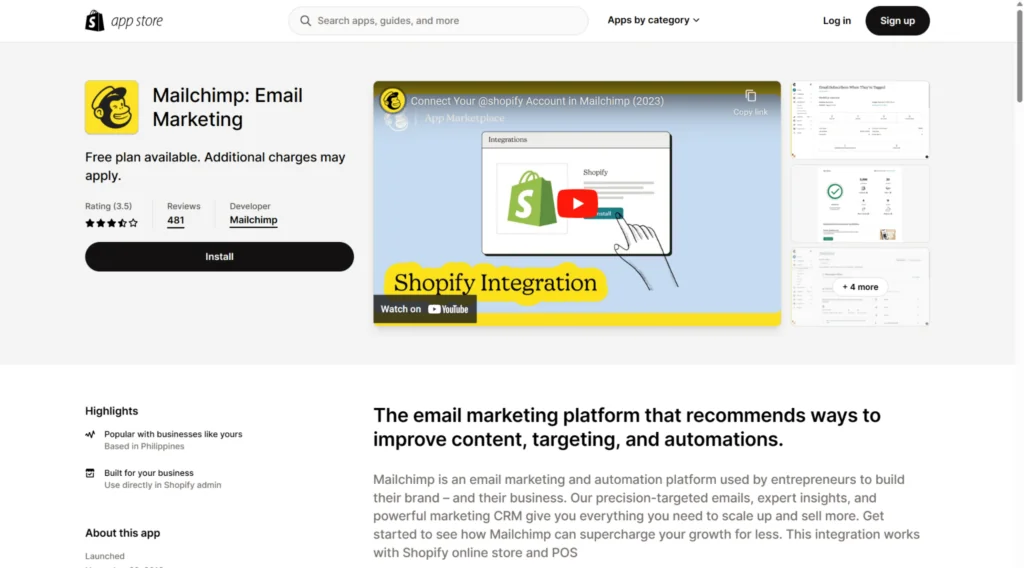
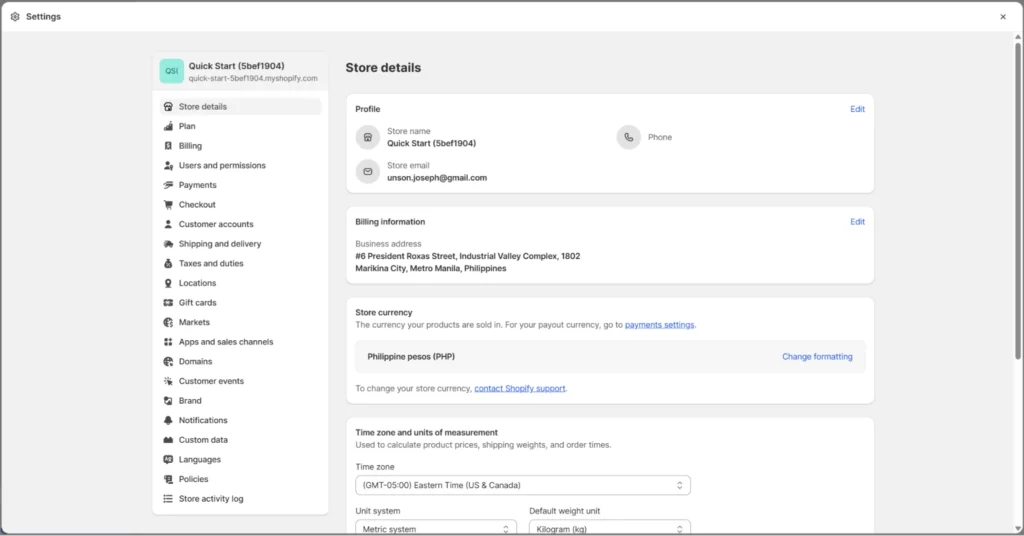
You can also adjust Settings like your Store details and Policies through a single menu.
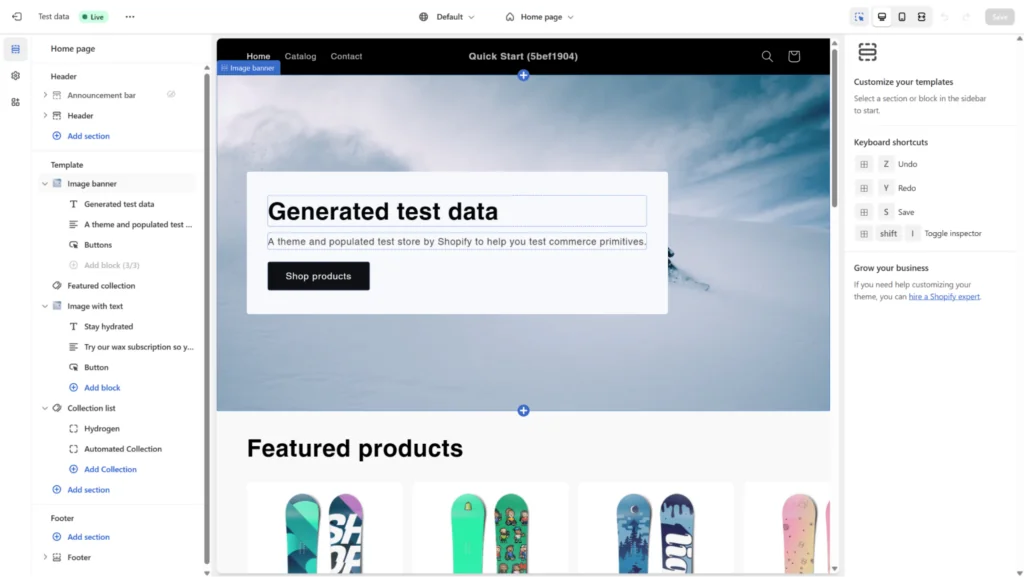
Website customization is streamlined as well, thanks to Shopify’s user-friendly editor.
eBay
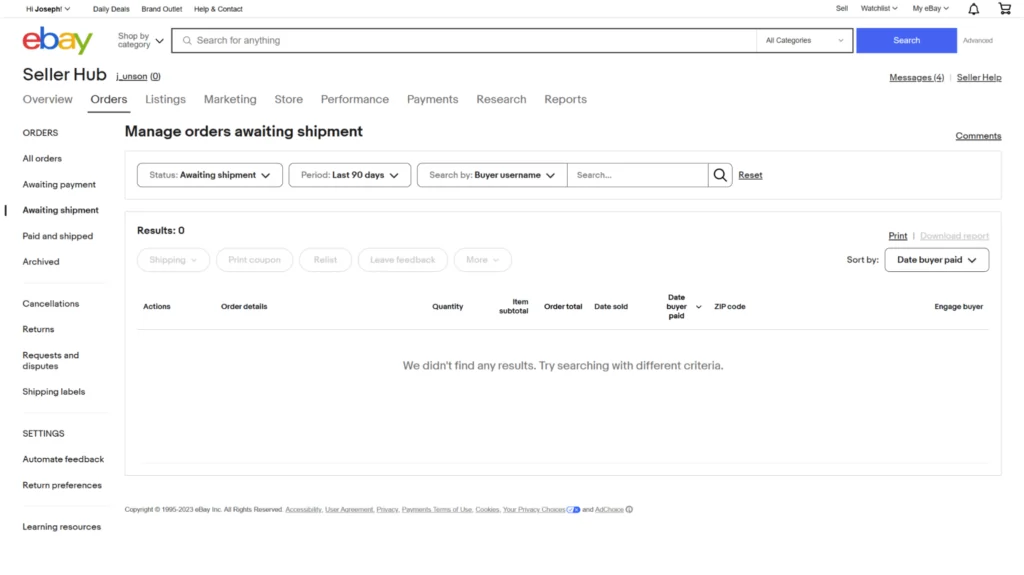
In eBay, your Seller Hub acts as your admin, where you manage and view:
- Orders
- Listings
- Marketing
- Your store
- Performance metrics
- Product research
- Payments
- Reports
The user interface (UI) feels outdated, though, and everything looks compressed. The UI for account management is lackluster as well.
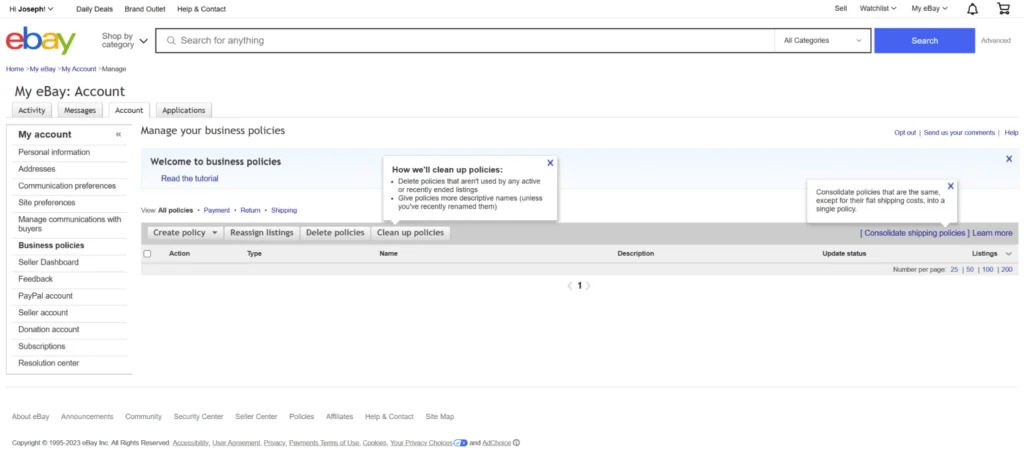
However, the platform does simplify creating return, shipping, and payment policies, which you can set up during store creation.
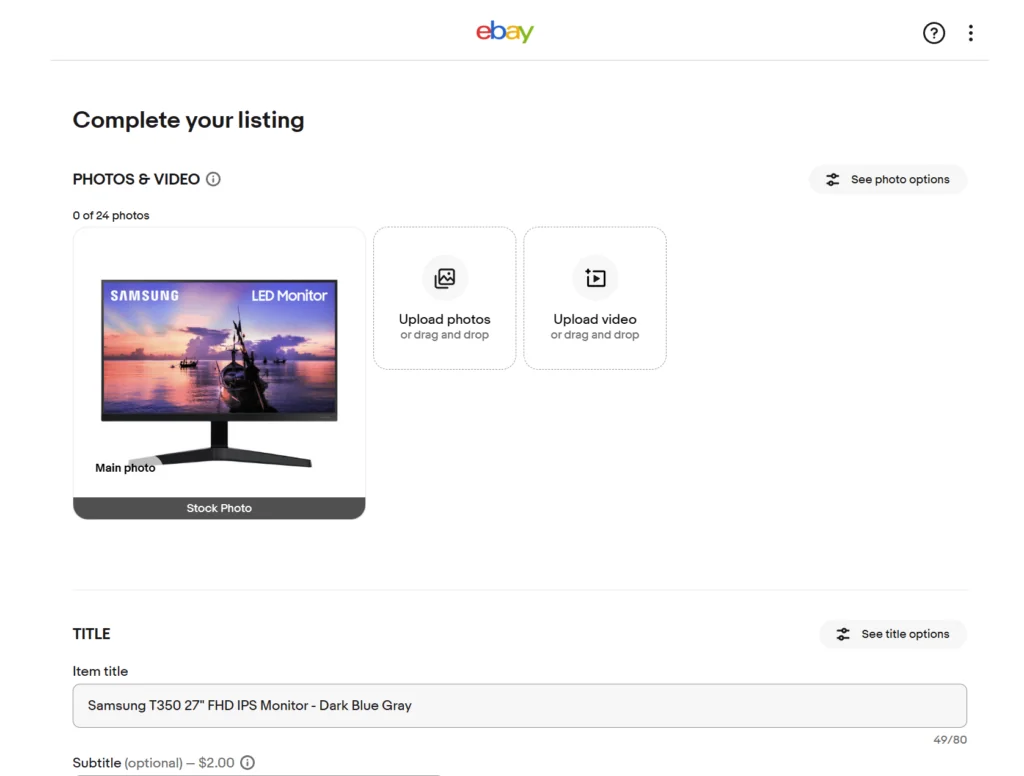
Listing items only involves a quick search—if information is already available on eBay. Then, you can input the rest yourself, including your product’s:
- Title
- Category
- Description
- Variations
- Price
- Specifications
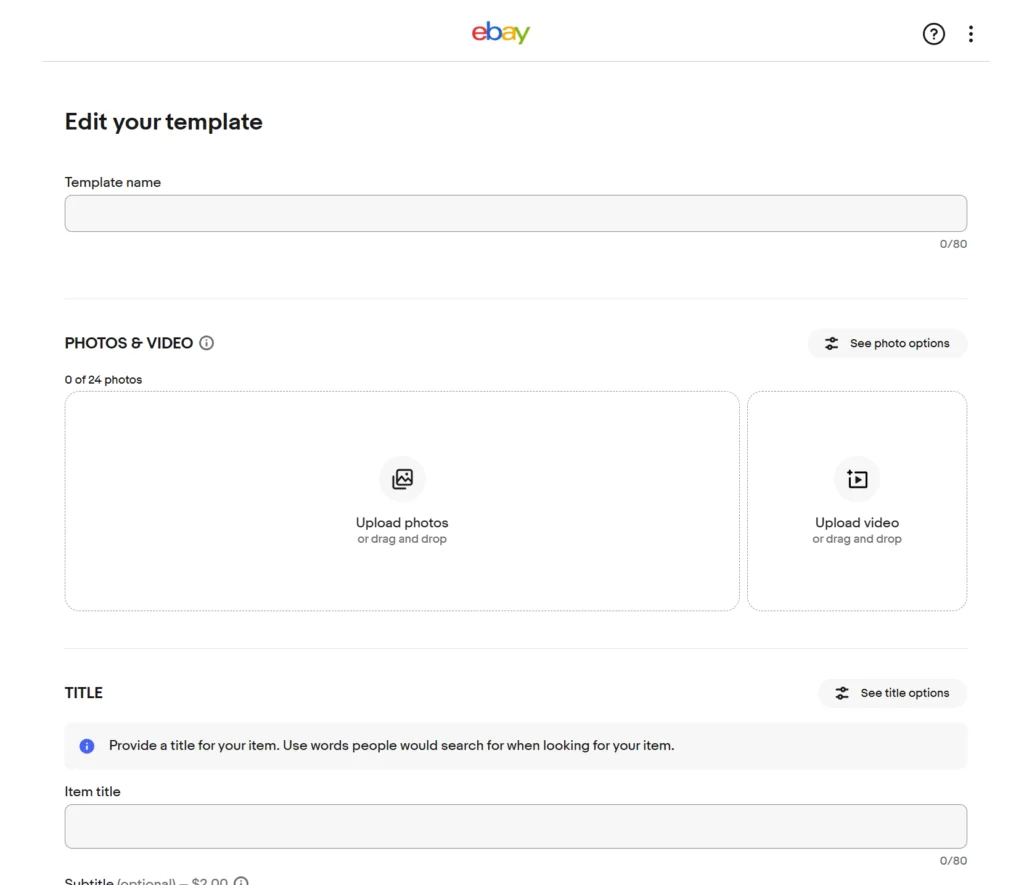
You can also build listing templates, which make it easier to create future listings and are helpful for selling branded goods.
Winner: Shopify
Although adding products on both platforms is relatively simple, Shopify offers a more intuitive overall experience.
eBay’s UI feels old-fashioned and convoluted in contrast, and, with everything being tightly knit, navigation can be confusing.
Payment options
Offering multiple payment methods eases checkout for customers, and each platform offers something different.
Shopify

We mentioned Shopify has secure payment options through its gateway, Shopify Payments. They span:
- Digital wallets: Apple Pay, Google Pay, and more
- Credit and debit cards: Visa, Mastercard, American Express, Discover
- Local payment methods: iDEAL in the Netherlands, Sofort in Germany, and more
- Manual options: Cash, cash on delivery (COD), bank transfers
The platform also eliminates fees for third-party transactions completed through:
- Shopify Payments
- Shop Pay
- Shop Pay Installments
- Paypal Express
Manual methods don’t incur charges either, so you avoid costs that would diminish your profits.
eBay
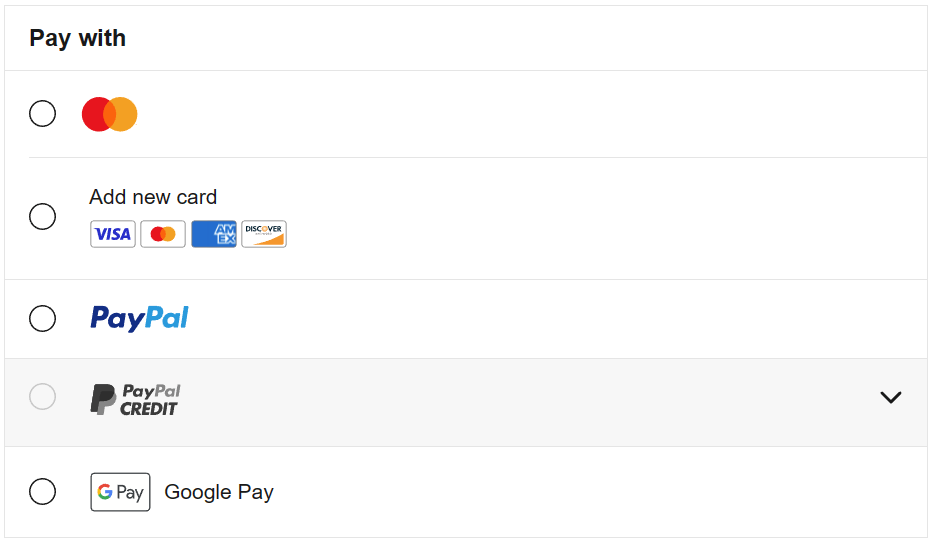
eBay’s payment options are also varied and automatically added when you create a listing. They include:
- Apple Pay
- Google Pay
- PayPal
- Credit card
- Debit card
Based on either the country you’re selling in or your product’s category, these additional options may also be available:
- Checks
- Money orders
- Cash on pickup
- Wire transfer
Winner: Tie
eBay offers a decent range of options, including a few country-dependent ones that Shopify doesn’t. However, Shopify’s payment gateway can eliminate transaction fees and minimize costs.
Customization and branding
When comparing design options, Shopify and eBay sit on opposite ends of the spectrum.
On the one hand, Shopify empowers merchants to create completely unique and customized experiences, complete with apps and integrations to extend functionality where their base platform doesn’t.
On the other hand, eBay has almost a cookie-cutter approach wherein merchants create uniform listings, relying on product photos and other content to set their listing apart.
The hierarchy and structure of an eBay product page remains the same from merchant to merchant, and you don’t get much in the way of page design.
Shopify
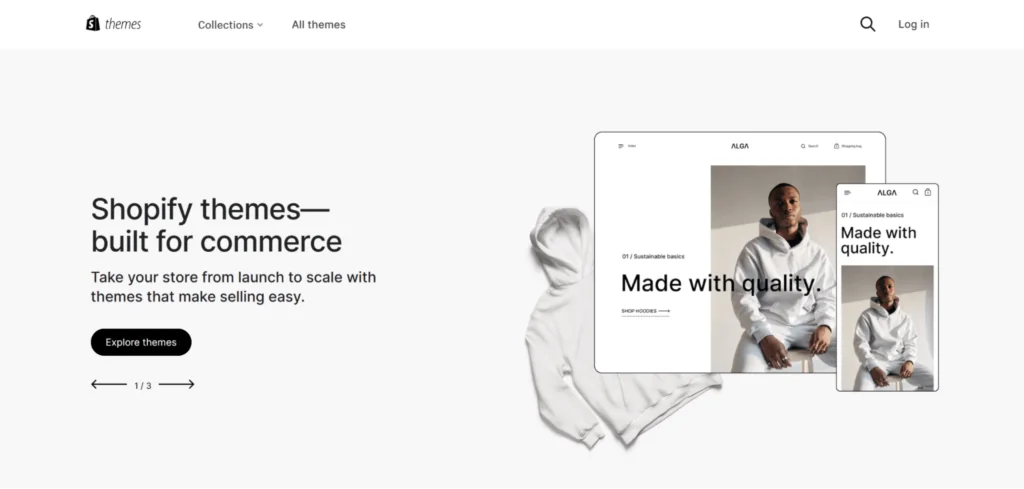
Shopify’s themes provide your store with a solid foundation—they’re what you build on to achieve your brand’s look and feel.
The platform’s user-friendly theme editor, meanwhile, possesses two features that enhance convenience:
- Page templates (which you can access from the dropdown menu at the top) let you instantly create a homepage, about us page, product pages, and more.
- Sections let you incorporate elements like featured collections, slideshows, and videos.
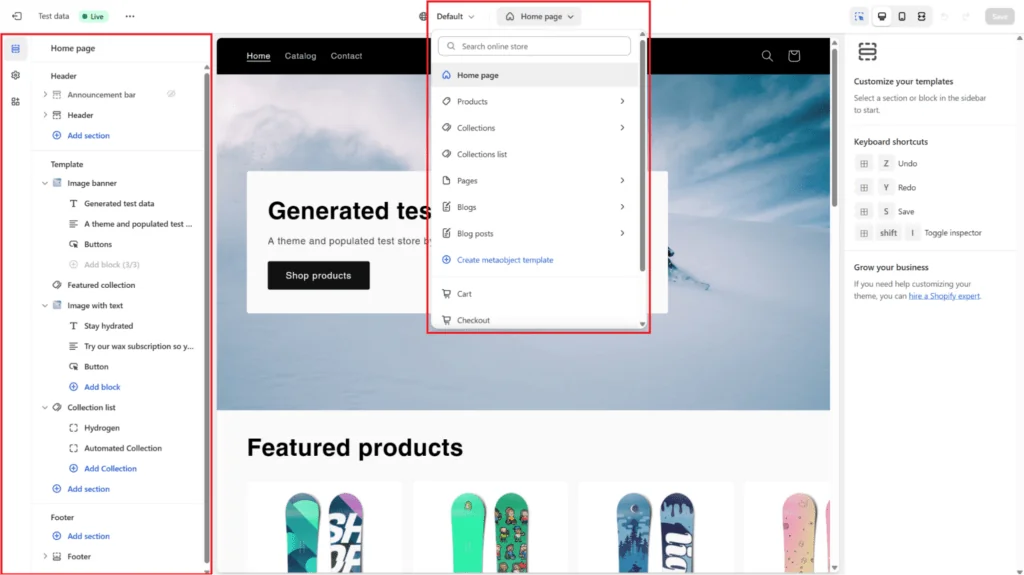

For more complex designs, you can use code, but that obviously requires technical know-how.
To simplify intricate customization and unify your brand’s aesthetic across your store, a tool like Shogun’s Page Builder can streamline page template creation.
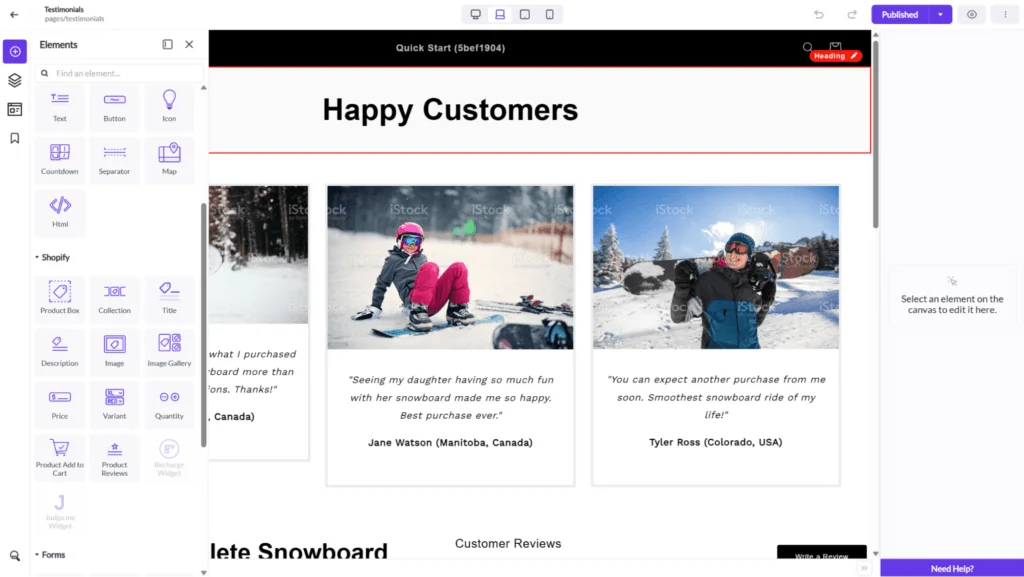
Its drag-and-drop functionality lets you easily structure pages, as well as add content like images, text, and elements from your Shopify store like galleries and reviews.
eBay
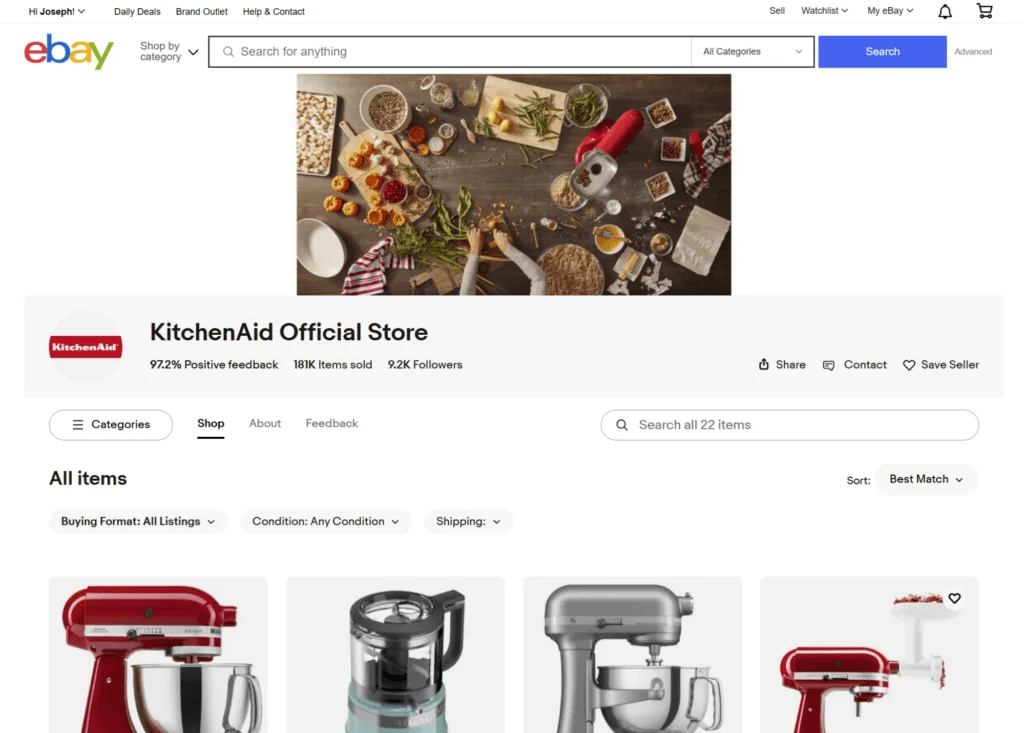
eBay’s customization and branding options, on the other hand, are extremely limited and only accessible through a Basic subscription or higher.

You’re only able to tailor your store’s:
- Name
- Main image
- Logo
- Description
- Featured categories
- Featured items
- Marketing banner
- Store video, which you can place in the About section
- Policies
Winner: Shopify
eBay provides the bare minimum for store design, while Shopify’s options are much more comprehensive.
Marketing and SEO
Shopify and eBay share some similarities in terms of their marketing and SEO capabilities, but the latter’s offering was noticeably lacking.
Shopify
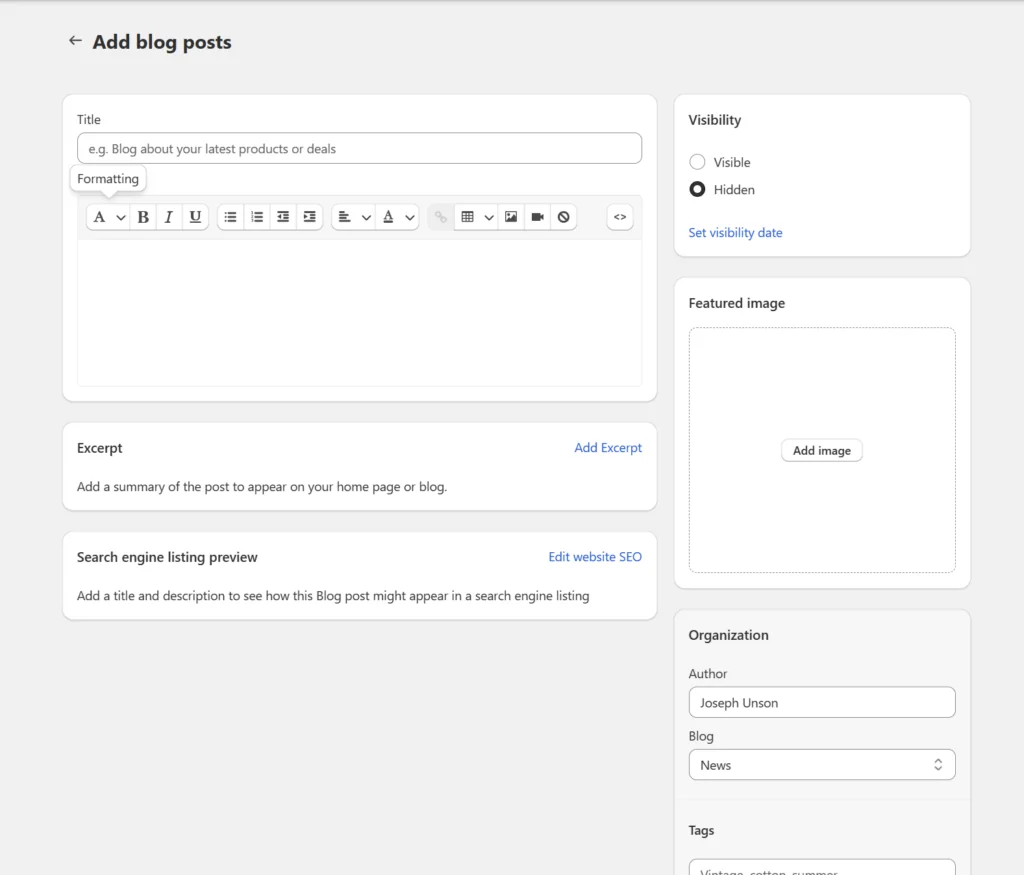
Shopify offers a comprehensive marketing toolkit that simplifies the production of engaging blogs.
You can also enable email marketing automations as well so you constantly engage customers and reengage those who leave.
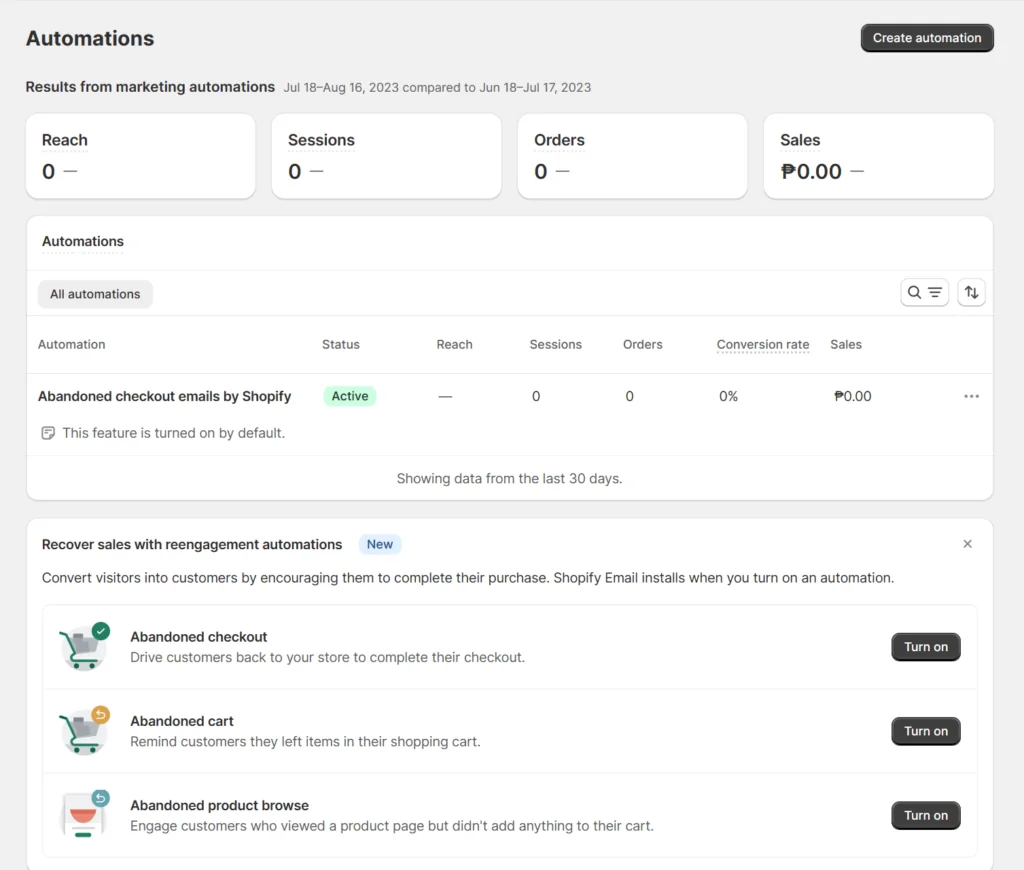

Shopify even lets you add social platforms like Facebook and Instagram as sales channels, which effectively expands your reach.
Shopify Inbox, meanwhile, makes it possible to chat with customers directly.
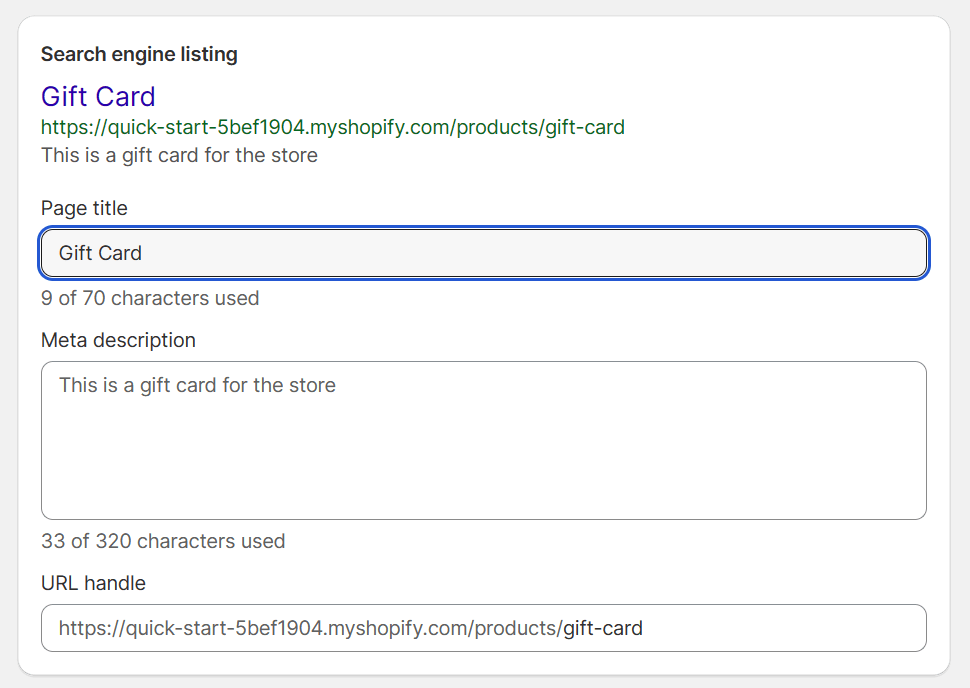
For built-in SEO, the platform offers a mix of automated and manual capabilities.
For instance, Shopify generates canonical tags, and you can edit the title tags, meta descriptions, and URLs of your pages, blog posts, collections, and products.
Additionally, Shopify’s reporting capabilities let you analyze customer behaviors and develop matching strategies.
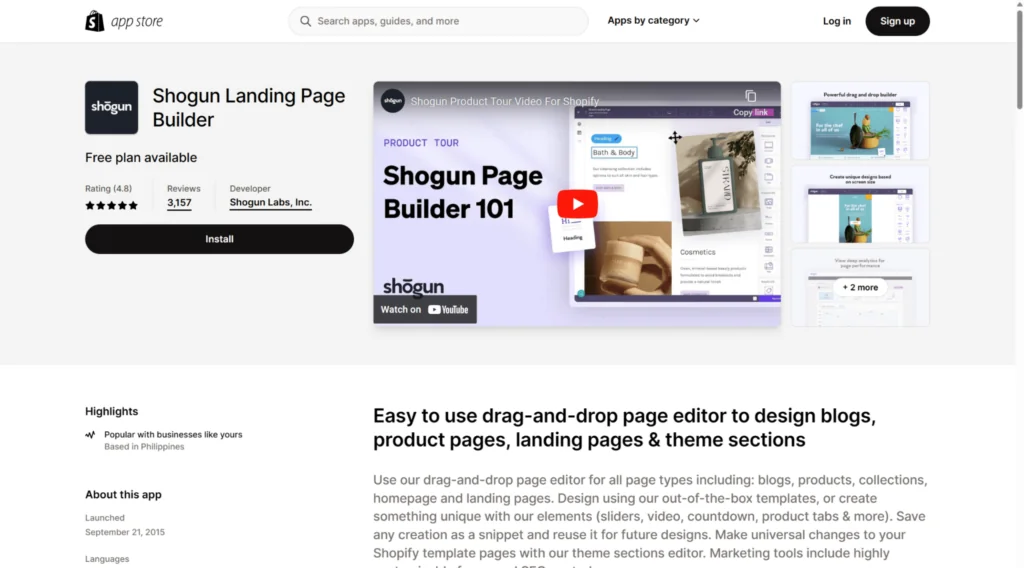
To top off your efforts, you can capitalize on an integration like the Shogun app, which lets you produce highly converting landing pages that drive marketing campaign results.
eBay
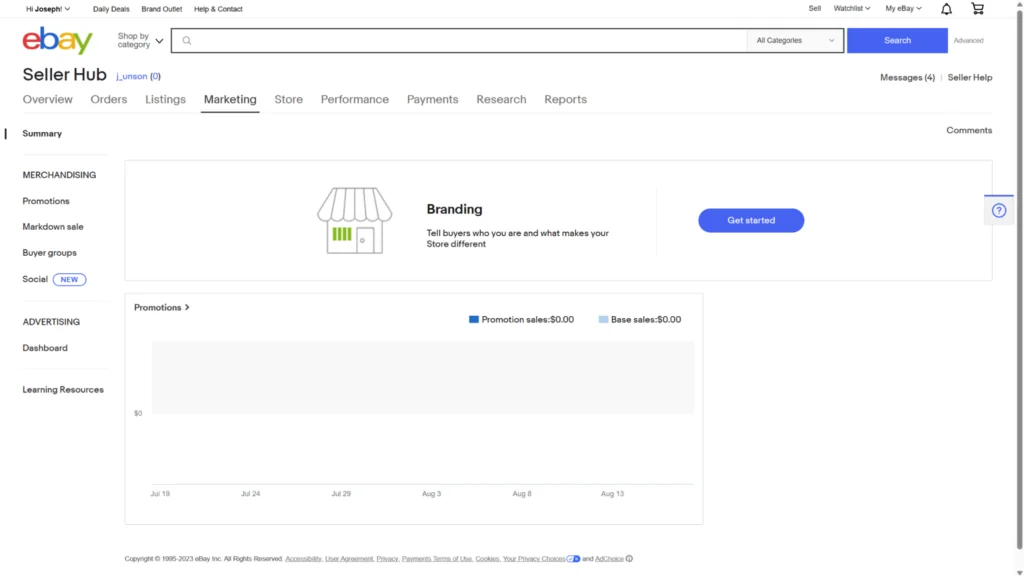
eBay’s marketing capabilities are built around three key features. First, the Promotions Manager enables offers such as:
- Order discounts
- Coupons
- Shipping discounts
- Sale events
- Volume pricing discounts
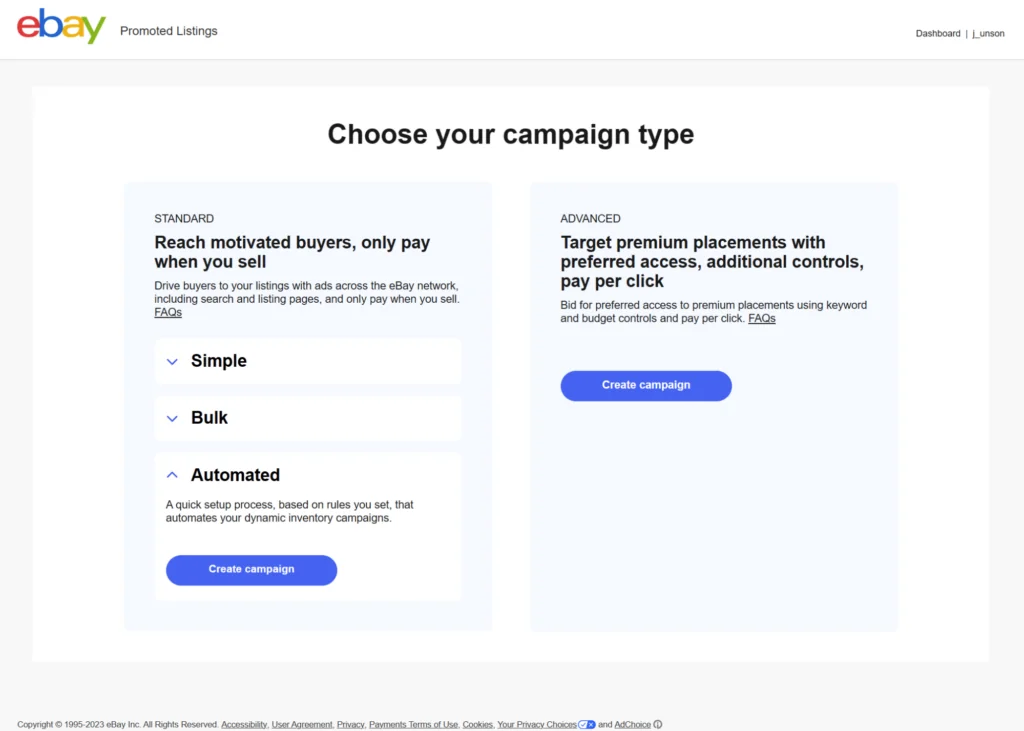
Second are Promoted Listings, the platform’s pay-per-click (PPC) option that advertises your listings across eBay’s network.
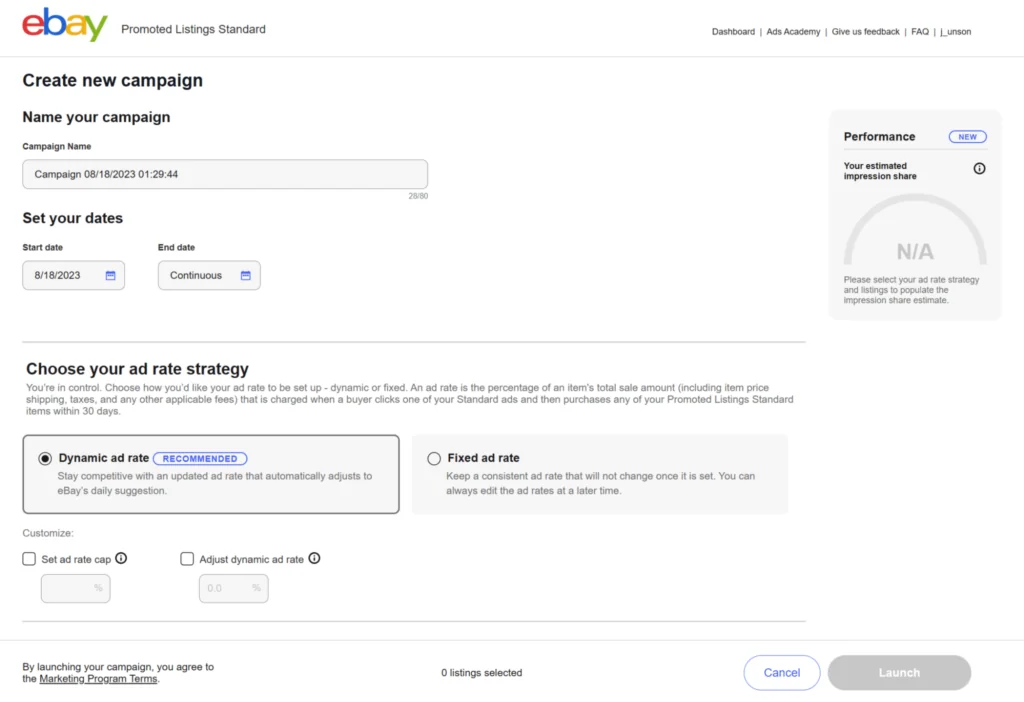
You can create four types of campaigns in this feature:
- Simple: Choose your listings, ad rates, and campaign duration
- Bulk: Advertise entire categories
- Automated: Promote listings based on a rule set
- Advanced: Bid for premium placements

Further, eBay’s social capabilities let you promote listings on Facebook, Instagram, and Pinterest.
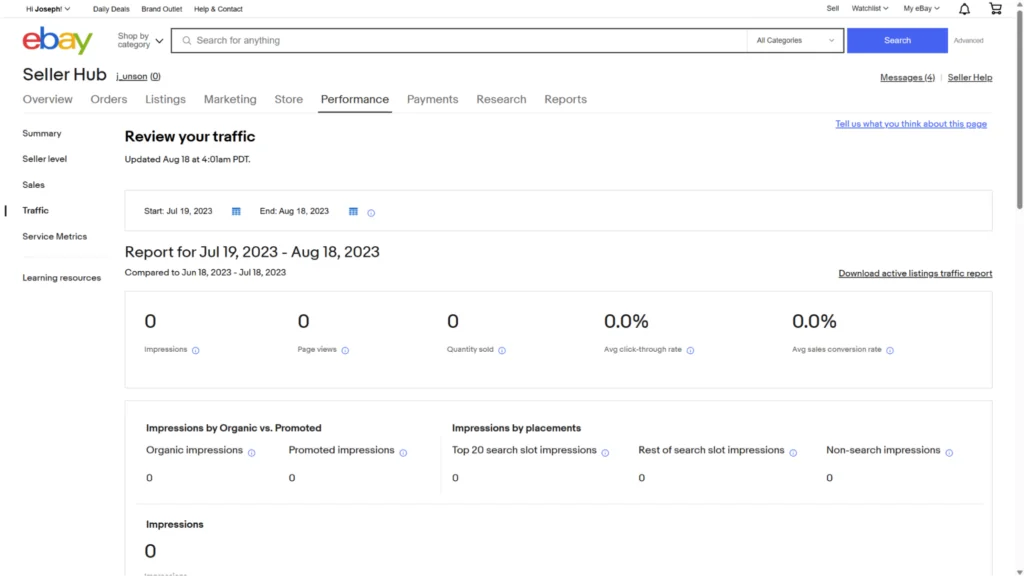
You can then review your marketing metrics under the Performance tab of your Seller Hub.
Unfortunately, eBay doesn’t provide SEO tools, and you’ll have to implement practices yourself, like using the right keywords and high-quality images.
Winner: Tie
Both platforms stock ample tools for marketing your store. While Shopify proves better for its built-in SEO capabilities, eBay competes by bringing its own audience of customers to merchant listings.
Ecommerce tools and apps
Between the two platforms, Shopify’s toolkit encompasses everything you need to build a profitable ecommerce venture.
Shopify
Besides the unlimited products and bandwidth we mentioned earlier, every Shopify plan has a long list of base features, including:
- Fraud analysis: Built into Shopify Payments, this flags potentially fraudulent orders, helping you avoid chargebacks and losses.
- Discount codes: Offer these to entice more customers.
- Market-based pricing: Set custom product prices and percentage price adjustments for certain countries or regions. You can also use Shopify Payments to display them in local currencies and set manual exchange rates.
- Staff logins: Restrict staff access to sensitive information while allowing them to complete basic admin tasks. Be sure to keep track of the changes they make.
- Reporting and analytics: Easily monitor your sales, orders, online store visitor data, and finances.
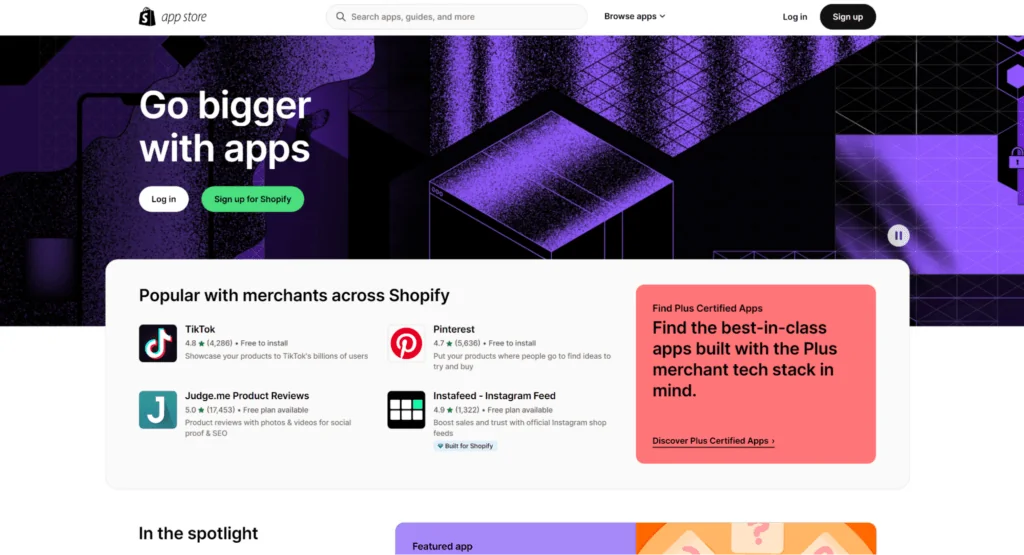
Although you’ve seen Shogun pop up a lot in this article, it’s only a drop in Shopify’s ocean of integrations for:
- Improving SEO and website performance
- Marketing
- Gathering reviews
- Streamlining shipping
- Multichannel selling
- And more
Combine these with the platform’s other features to unlock potentially limitless scalability.
eBay
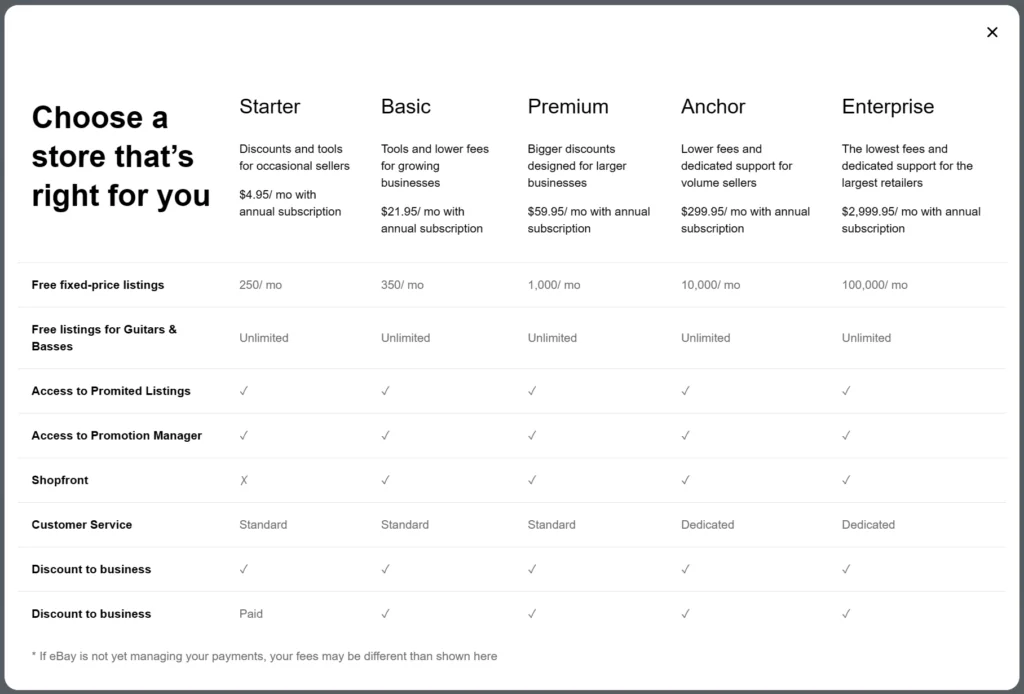
eBay’s subscriptions focus on lowering costs by increasing the limits for free listings—which ranges from 250 to 100K/month—and supplementing sellers with discounts.
Be aware, a storefront is only available for plans above the Starter one.
The platform’s Seller Hub and listing templates also help with managing and selling alongside the following additional capabilities:
- Marketing promotions
- Advertising
- Performance analytics
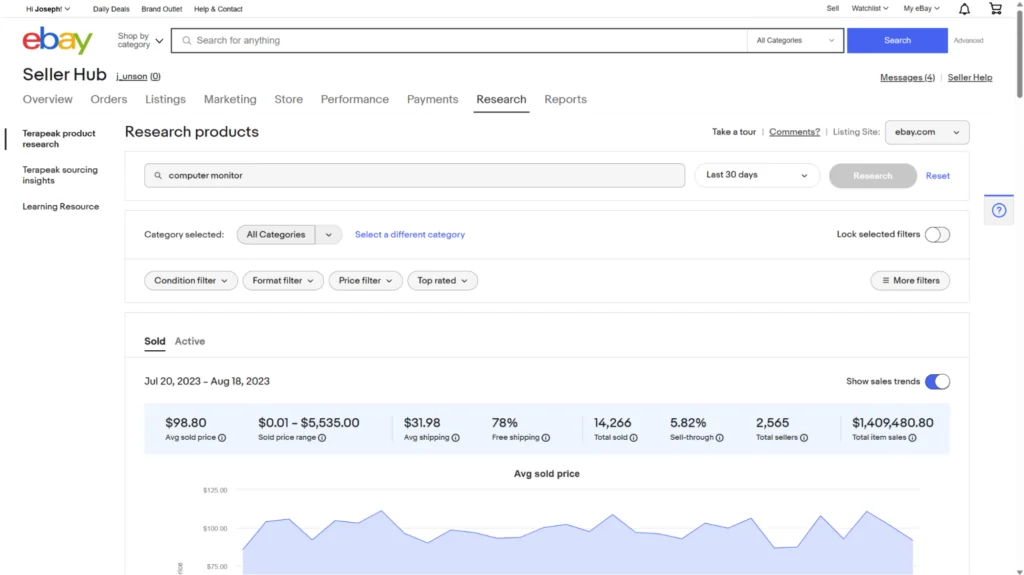
eBay also provides a product research tool, Terapeak, which helps pinpoint what to sell.
However, the platform lacks an expansive app ecosystem like Shopify’s. For added functionality, you’ll need to rely on external tools like:
- inkFrog: An eBay listing software
- Sellbrite: Helps with inventory syncing
- ShelfTrend: For deep product research
Winner: Shopify
Shopify’s deep feature set and app library can empower your brand for a wide ecommerce reach. In contrast, eBay’s overall toolkit falls short in some critical areas.
Omnichannel selling
Shopify and eBay both let you connect to various online channels, but in-person selling serves as the key distinction in this category.
Shopify

Shopify’s marketing features and integrations enable you to sell on social platforms and marketplaces like Amazon and Walmart.
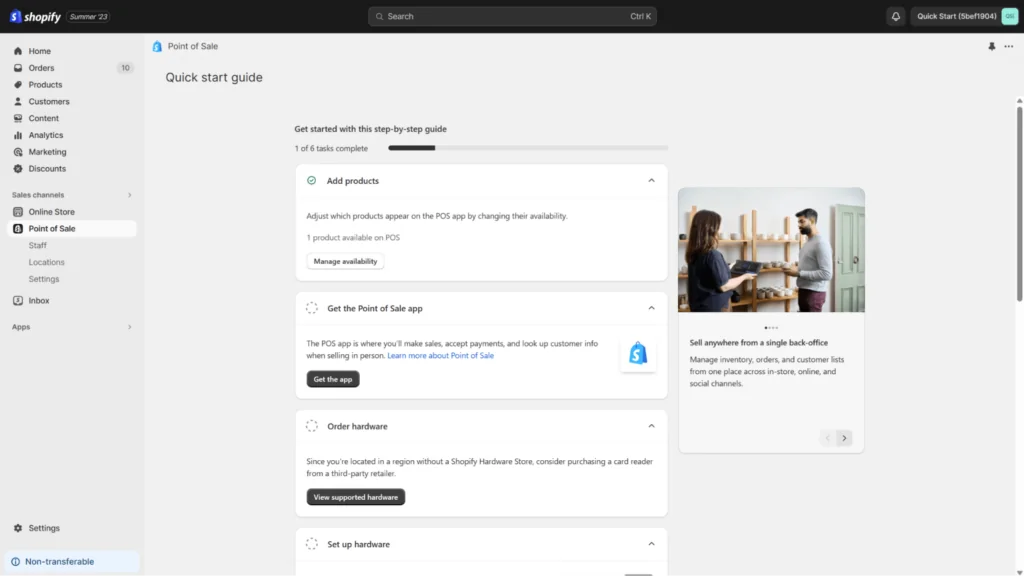
Where the platform really shines, though, is in in-person selling through Shopify POS, which streamlines online and offline payment processing, as well as inventory management.
It even offers POS hardware and lets you manage staff accounts easily.
eBay
With eBay, you can connect to Facebook, Instagram, and Pinterest to create custom posts and highlight your store, categories, or listings.
Meanwhile, its advertising option allows for listings promotion throughout the platform and its partner sites.

In terms of in-person selling, however, eBay only lets you offer in-store pickup and local pickup as shipping options, or you can arrange in-person collection.
Winner: Shopify
Though both platforms enable selling on multiple online channels, Shopify offers significantly more to produce powerful in-person selling experiences.
Fulfillment and shipping
To handle and send products to customers, the two platforms offer abundant solutions.
Shopify

Shopify’s Fulfillment Network is an end-to-end option that lets merchants take advantage of the platform’s transportation partnerships.
It takes care of (and also lets you manage) orders, inventory storage, distribution, delivery, and returns.
Shopify Shipping allows merchants to self-fulfill orders while leveraging Shopify’s carrier rates, conveniently being able to print labels from their Shopify account.
eBay

On eBay, it’s your responsibility to package and handle products, and you also have to manage returns. The platform is more focused on comprehensive shipping, as demonstrated through the following service offerings:
- eBay Labels: Add shipping services when listing merchandise, then print their labels when sold.
- Domestic shipping: For U.S. shipping, eBay maintains partnerships with USPS, UPS, FedEx, and, for smaller items, the eBay standard envelope service.
- International shipping: The platform’s international shipping program lets you reach buyers in more than 200 countries and eliminates the hassle of managing shipping, customs, and returns.
- Freight shipping: Handles oversized items.
Winner: It depends
For this category, choose based on your needs. Consider whether you want to handle your products, sell oversized items, or sell to multiple international markets.
A mix of these criteria will point you definitively toward either Shopify or eBay.
One advantage Shopify has over eBay is that they have a managed fulfillment network that handles logistics for you.
An advantage eBay has is their ability to serve international customers with a global shipping program.
Customer support
Customer service is what can turn an unfortunate situation into either a pleasant surprise or a frustrating disaster.
Having good customer support is imperative when your livelihood is on the line, so consider which sales channel comes with better service.
Shopify

Shopify offers 24/7 support in various ways, the most accessible being its support pages that cover a broad range of topics.
If they don’t help, you can get in touch via chat or by leaving a message. The Shopify Community provides insightful support as well.
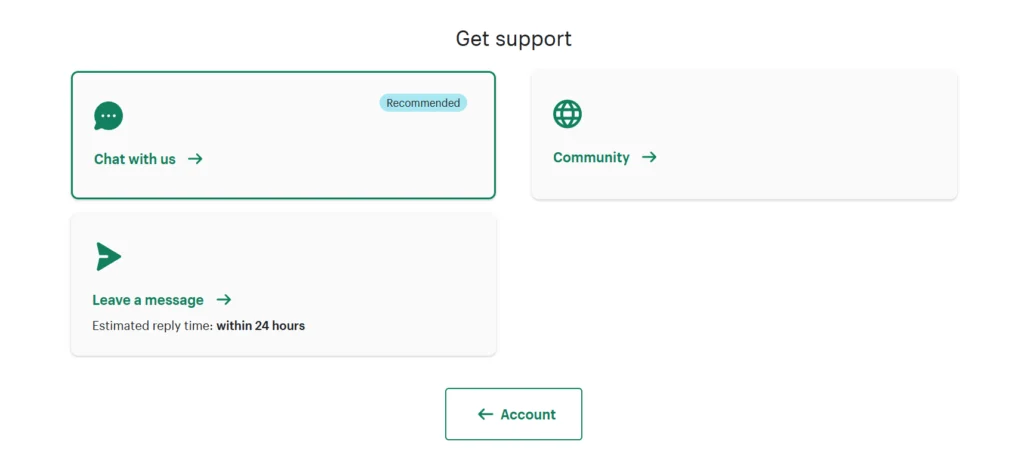
eBay
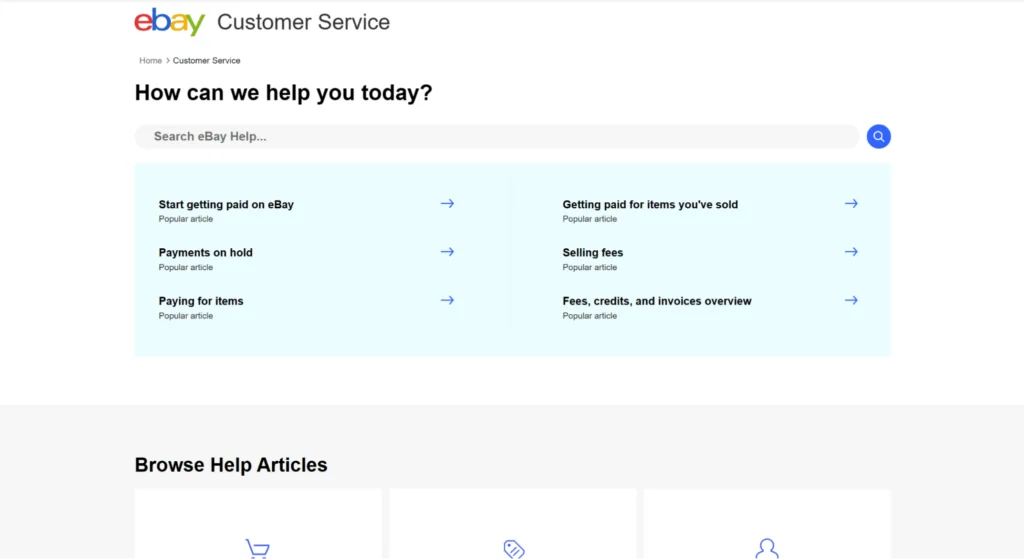
eBay’s customer support options vary according to your plan. Stores on the Starter to Premium plans receive standard service, which provides access to:
- Support pages
- An automated assistant
- An agent
- The eBay community
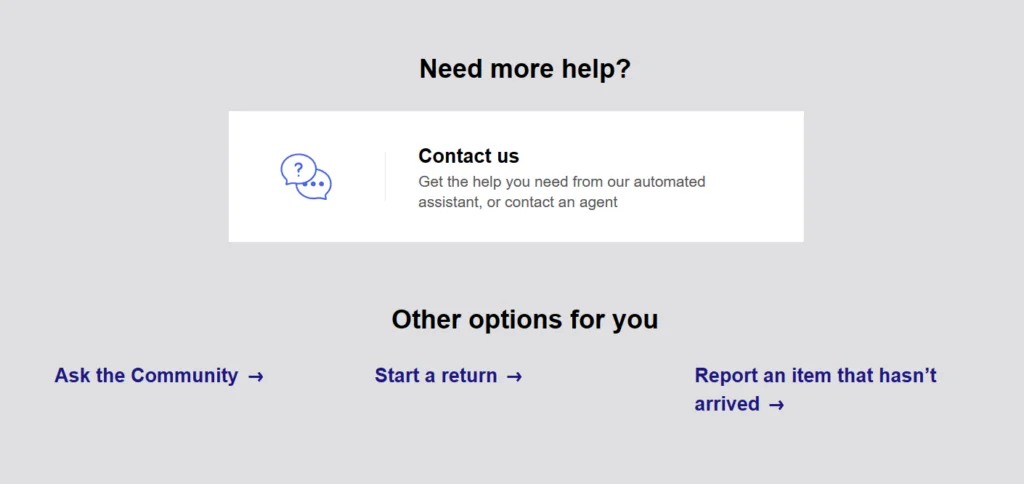
Anchor and Enterprise subscribers can additionally enjoy dedicated, round-the-clock support via phone or email.
Winner: Shopify
Both platforms offer complete customer support options, but unlike eBay, Shopify guarantees them across all of its plans.
The difference between Shopify and eBay
Shopify is typically best for businesses that value more control, customizability, a branded experience, and the ability to scale.
eBay is ideal for brands looking to tap into a pre-built audience with ease and simplicity.
Ask yourself the following questions to pinpoint which platform is ideal for you:
- Business model: Are you building a branded online presence or just selling to a broad, accessible market without any need for intricate design?
- Budget: How much can you invest into your store? Remember, you have to allocate resources for your products, marketing, and customer experience as well.
- Control: Do you want entire customer experiences, from website visits to checkout, to be on brand? Or, are you okay with mimicking other sellers on your chosen platform?
- Goals: In the future, do you want your business to scale up and establish strong brand recognition? Or, do you simply want to maximize your visibility and sales?
What type of ecommerce business is best suited for Shopify?
Shopify is best for starting from scratch. Sam McEwin emphasizes the importance of raising a business from the ground up:
“For me, building your own brand and market is always the better option. You control the relationship with your customers, the experience, and you can grow something of lasting value.”
In that regard, Shopify takes the lead, offering free reign over your online presence alongside flexibility, scalability, and tons of integrations.
It’s best for people willing to invest resources into tailoring their end-to-end customer experience.
Similarly, Tom Golubovich, head of marketing for Ninja Transfers, advocates Shopify for young businesses looking to set up a unique ecommerce presence.
He highlights how “…the biggest advantage of Shopify was its versatility, features, and add-ons that make it the perfect platform for fresh, smaller brands looking to start with ecommerce.”
What type of ecommerce business is best suited for eBay?
Though its customizations are limited and you’re subject to its policy changes, eBay is the best option for prioritizing simplicity and instantly reaching a massive, broad audience.
Just remember, you’ll incur the platform’s many fees and see lower margins, but you can still control costs since they’re based on successful sales.
Shopify-eBay integration: Why not sell on both?
You may be leaning toward a single platform by this point, but it’s actually possible to use both. If it fits your strategy, you can enjoy the best of both worlds by using an eBay-Shopify app.
As Sam McEwin explains:
“Shopify… has plugins that allow you to take your Shopify inventory into eBay’s marketplace (and Amazon, too, for what it’s worth). So, you can build a long-lasting brand whilst dipping into eBay for some instant sales.”
This type of approach can diversify your revenue streams and expand your reach. You can use apps such as the CedCommerce eBay Integration, Shopify Marketplace Connect, or Professional Importer for eBay to name a few.
These tools can upload your Shopify offering to eBay and accurately sync inventory and orders between the two.
Shopify vs eBay FAQs
Now that we’ve covered all the bases, let’s finish off the article by answering some of the most common questions online.
Can I use both Shopify and eBay for my online store?
Selling on both platforms is viable and potentially lucrative; you only need an eBay connector from Shopify’s app store. You can sell on the two simultaneously or only use the second when relevant.
For example, you can operate primarily on Shopify, then use eBay to sell returned items and recoup losses. If you offer electronics and appliances, you could offer smaller products through Shopify, then list larger ones on eBay for its freight shipping.
Which platform offers better SEO tools?
Shopify provides built-in optimization tools, as well as SEO apps. eBay doesn’t, requiring you to implement best practices without assistance.
Which platform offers broader customization options?
eBay provides the bare minimum for store customization, while Shopify lets you tailor everything from store aesthetics to your checkout process.
Additionally, for any complex design requirements, you can manually tweak Liquid (Shopify’s template code).
Can I run flash sales or discounts on both Shopify and eBay?

Yes, both platforms support these promotional strategies.
Shopify lets you easily offer discounts, while its campaign functionalities and marketing integrations can assist with implementing flash sales. eBay enables these tactics through its Promotions Manager.
Can I sell digital products on Shopify and eBay?
Yes, both platforms accommodate digital items. We have a guide that can show you how to sell digital products on Shopify.
As for eBay, only approved sellers can sell these types of online goods, and they have to comply with the platform’s policy on electronically delivered items.
Can I migrate my products and data from one platform to the other?
Yes, there are numerous Shopify integrations that can help you move data from eBay to Shopify or vice versa. Some of the popular apps to do this include CedCommerce, Shopify Marketplace Connect (formerly Codisto), and Professional Importer for eBay.
How do Shopify and eBay handle customer reviews and feedback?
Shopify has various premium apps that allow you to collect and add reviews to your store. Some of these include Yotpo, Loox, and Judge.me (all of which integrate with Shogun so you can display reviews beautifully).
eBay lets buyers leave positive, neutral, or negative feedback, as well as comments. Seller ratings are also displayed to help identify the best stores.
Shopify vs eBay: Which platform should you choose?
Shopify and eBay each have unique strengths and weaknesses, so your choice will be subjective.
It boils down to analyzing your business’s individual needs, exploring both platforms thoroughly, then making your judgment according to the information you’ve gathered.
If it fits your growth plans, you can use both and go for a hybrid approach.
This decision is incredibly important and deserves your time and attention. Research is a major ally here and will guide you to the appropriate choice that’ll drive ecommerce success for your brand.
#cta-visual-pb#<cta-title>Create the buyer experience of your dreams<cta-title>Create a highly branded and recognizable website and purchase flow with Shogun Page Builder.Start designing for free

Rachel Go
Rachel is a remote marketing manager with a background in building scalable content engines. She creates content that wins customers for B2B ecommerce companies like MyFBAPrep, Shogun, and more. In the past, she has scaled organic acquisition efforts for companies like Deliverr and Skubana.



